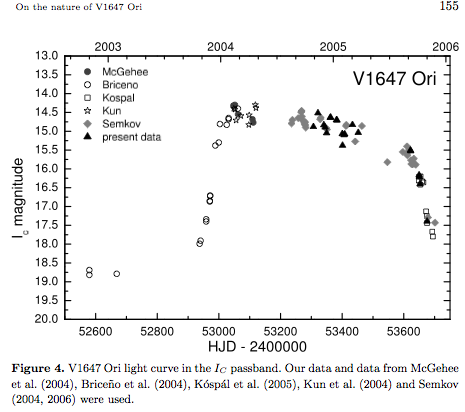Difference between revisions of "Triggers:FUOri"
From Gaia Science Alerts Working Group
Jump to navigationJump to search (Created page with 'FU Orionis (V1647 Ori) is young pre-main sequence stars, illuminating a McNeil's nebula in the vicinity of NGC 2068 star-forming region. File:FUOri Plot from [http://www.ta3...') |
|||
| Line 1: | Line 1: | ||
FU Orionis (V1647 Ori) is young pre-main sequence stars, illuminating a McNeil's nebula in the vicinity of NGC 2068 star-forming region. | FU Orionis (V1647 Ori) is young pre-main sequence stars, illuminating a McNeil's nebula in the vicinity of NGC 2068 star-forming region. | ||
| − | [[File:FUOri]] | + | [[File:FUOri.png]] |
Plot from [http://www.ta3.sk/caosp/Eedition/FullTexts/vol36no3/pp149-157.pdf D.Chochol et al. 2006]. | Plot from [http://www.ta3.sk/caosp/Eedition/FullTexts/vol36no3/pp149-157.pdf D.Chochol et al. 2006]. | ||
| + | |||
| + | Characteristics: | ||
| + | |||
| + | * Very rare | ||
| + | * Outbursts repeat with a time scale of 40 years (1978, 2003) | ||
| + | * Amplitude: 5 mag over 4 months | ||
| + | * Outbursts last for 2 years | ||
| + | * Spectrum: red, heavily veiled continuum with strong emission of <math>H_{\alpha}</math>; in blue consistent with an early B spectral type | ||
| + | * X-ray variability present | ||
| + | |||
| + | More general characteristics of FUors, based on other examples | ||
| + | |||
| + | * FU Ori and V1057 Cyg rise over 1 yr, whereas V1515 Cyg rise over 20 years | ||
| + | * FU Ori and V1515 Cyg decline over 20-100 years, V1015 Cyg decays faster (10 yrs) | ||
| + | * Spectra: F or G supergiants | ||
| + | * Some of them are embedded in nebulas | ||
| + | * OO Serpentis is newly discovered another example of FU Ori [http://arxiv.org/abs/0705.1231 Kospal et al. 2007]. | ||
Revision as of 12:36, 10 July 2009
FU Orionis (V1647 Ori) is young pre-main sequence stars, illuminating a McNeil's nebula in the vicinity of NGC 2068 star-forming region.
 Plot from D.Chochol et al. 2006.
Plot from D.Chochol et al. 2006.
Characteristics:
- Very rare
- Outbursts repeat with a time scale of 40 years (1978, 2003)
- Amplitude: 5 mag over 4 months
- Outbursts last for 2 years
- Spectrum: red, heavily veiled continuum with strong emission of <math>H_{\alpha}</math>; in blue consistent with an early B spectral type
- X-ray variability present
More general characteristics of FUors, based on other examples
- FU Ori and V1057 Cyg rise over 1 yr, whereas V1515 Cyg rise over 20 years
- FU Ori and V1515 Cyg decline over 20-100 years, V1015 Cyg decays faster (10 yrs)
- Spectra: F or G supergiants
- Some of them are embedded in nebulas
- OO Serpentis is newly discovered another example of FU Ori Kospal et al. 2007.